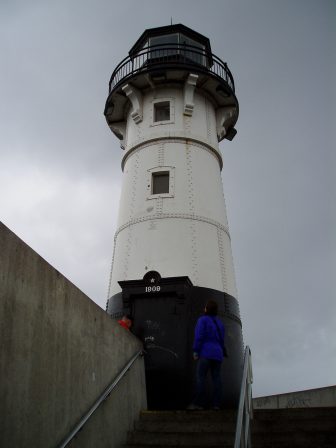
The Duluth Harbor North Pier Light was built in 1910 to help ships navigating Duluth’s shipping canal. Image: U.S. Coast Guard
By Josh Bender
Three Great Lakes lighthouses were recently added to the National Register for Historic Places.
They include Minnesota’s Duluth Harbor North Pier Light, constructed in 1910, and South Harbor Breakwater Outer Light, constructed in 1901. Both were built to help ships navigate Duluth’s shipping canal, said U.S. Coast Guard historian Daniel Koski-Karell, who applied to get the lighthouses added to the register.
The North Pier Light emits a red light visible every three seconds for up to 16 miles on a clear day, according to the application for the designation. The Breakwater Outer Light emits a fixed green light visible for up to 17 miles in clear weather.
The third newly listed light is Michigan’s Presque Isle Harbor Breakwater Light built in

The Duluth Harbor South Breakwater Outer Light was built in 1901 to help ships navigating Duluth’s shipping canal. Image: U.S. Coast Guard
1941 to assist in shipping out iron ore mined in Michigan’s Upper Peninsula, Koski-Karell said. Standing in Presque Isle Harbor, the light is still used for this purpose today.
The harbor is the ninth busiest in the Great Lakes, according to the National Register application. In addition to shipping out iron ore, the harbor receives freighters bearing coal to fuel the Presque Isle Power Plant.
The Presque Isle Light emits a red flash every four seconds that is visible for 11 miles in clear weather, according to the application.
The mostly honorary gesture of historic designation is a step in finding a more permanent solution for maintaining the lights, said National Register historian Alexis Abernathy.
There are now 144 Great Lakes Basin lighthouses on the National Register of Historic Places, said National Park Service maritime historian Anna Holloway.
Advances in navigational technology have taken away the Coast Guard employed lighthouse keepers who handled maintenance, Koski-Karell said. Modern lighthouses are automated and maintenance has been reduced to occasional check ups.
The Presque Isle Light uses an electronic foghorn and relies on solar-powered batteries for energy.
Both Duluth Harbor lighthouses had antique beacon lights that were replaced by modern LED lights in 2014.
Prior to this improvement, the Duluth Harbor South Breakwater Outer Light used a Parisian-made beacon light from 1877, according to the application.
The Coast Guard still needs the Duluth Harbor and Presque Isle lights operational, Koski-Karell said. Adding the lights to the register helps open the door for them to be donated to a non-profit organization or auctioned to a private owner.
Of the Great Lakes Basin’s 388 lighthouses, 70 percent provide navigational support, according to Great Lakes Lighthouse Keepers Association 2014 statistics.
“One of the major reasons for transferring the properties is that as the lighthouses age, the cost (of maintenance) is very burdensome to the Coast Guard,” Koski-Karell said. The new ownership would take over maintenance duties under Coast Guard supervision.
Getting the Duluth Harbor and Presque Isle lights to that point will take three to five more years, he said. The Coast Guard must first clean the lighthouses and decide whether to give them up.

The Presque Isle Harbor Breakwater Light was built in 1941 to guide vessels shipping iron ore mined in Michigan’s Upper Peninsula. Image: U.S. Coast Guard
New owners often turn the lighthouses into homes, museums, or lodging for tourists, Holloway said.
The lights would go to auction if the Coast Guard cannot find nonprofit groups willing to maintain and keep them open them for educational use, Holloway said.
All of this is done under the National Historic Lighthouse Preservation Act of 2000, she said. Since the act’s implementation; 14 of the Great Lakes Basin’s lighthouses have been sold to private owners, 13 have been given to local governments, 16 have been given to nonprofit groups and 2 have been transferred to other federal agencies. The remaining 343 lighthouses in the basin are still owned the by the Coast Guard.
There are 82 lighthouses available for tours in the Great Lakes Basin, according to the Great Lakes Lighthouse Keepers Association 2014 statistics.
Preserving them is important, said Lee Radzak, historic site manager at Minnesota’s Split Rock Lighthouse. “They reflect the character of the shipping history and the rich maritime history we have in the Great Lakes.”